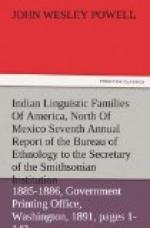> Guaicuri, Keane, App. Stanford’s
Comp. (Cent. and So. Am.), 476,
1878 (between 26th and 23d parallels).
> Ushiti, Latham in Trans. Philolog.
Soc. Lond., 88, 1856 (perhaps a
dialect of Waikur). Latham, Opuscula,
353, 1860.
> Utshiti, Latham, El. Comp. Phil., 423, 1862 (same as Ushiti).
> Pericu, Latham in Trans. Philolog.
Soc. Lond., 88, 1856. Latham,
Opuscula, 353, 1860. Orozco y Berra,
Geografia de las Lenguas de
Mexico, map, 1864.
> Pericui, Keane, App. Stanford’s
Comp. (Cent, and So. Am.), 476, 1878
(from 23 deg. N.L. to Cape S. Lucas
and islands).
> Seri, Gatschet in Zeitschr. fuer Ethnologie,
XV, 129, 1883, and
XVIII, 115, 1886.
Derivation: A Cuchan word signifying “sons of the river” (Whipple).
In 1856 Turner adopted Yuma as a family name, and placed under it Cuchan, Coco-Maricopa, Mojave and Diegeno.
Three years previously (1853) Latham[114] speaks of the Dieguno language, and discusses with it several others, viz, San Diego, Cocomaricopa, Cuohan, Yuma, Amaquaqua (Mohave), etc. Though he seems to consider these languages as allied, he gives no indication that he believes them to collectively represent a family, and he made no formal family division. The context is not, however, sufficiently clear to render his position with respect to their exact status as precise as is to be desired, but it is tolerably certain that he did not mean to make Diegueno a family name, for in the volume of the same society for 1856 he includes both the Diegueno and the other above mentioned tribes in the Yuma family, which is here fully set forth. As he makes no allusion to having previously established a family name for the same group of languages, it seems pretty certain that he did not do so, and that the term Diegueno as a family name may be eliminated from consideration. It thus appears that the family name Yuma was proposed by both the above authors during the same year. For, though part 3 of vol. III of Pacific Railroad Reports, in which Turner’s article is published, is dated 1855, it appears from a foot-note (p. 84) that his paper was not handed to Mr. Whipple till January, 1856, the date of title page of volume, and that his proof was going through the press during the month of May, which is the month (May 9) that Latham’s paper was read before the Philological Society. The fact that Latham’s article was not read until May 9 enables us to establish priority of publication in favor of Turner with a reasonable degree of certainty, as doubtless a considerable period elapsed between the presentation of Latham’s paper to the society and its final publication, upon which latter must rest its claim. The Yuma of Turner is therefore adopted as of precise date and of undoubted application. Pimentel makes Yuma a part of Piman stock.
[Footnote 114: Proc. London Philol. Soc., vol. 6, 75, 1854.]




